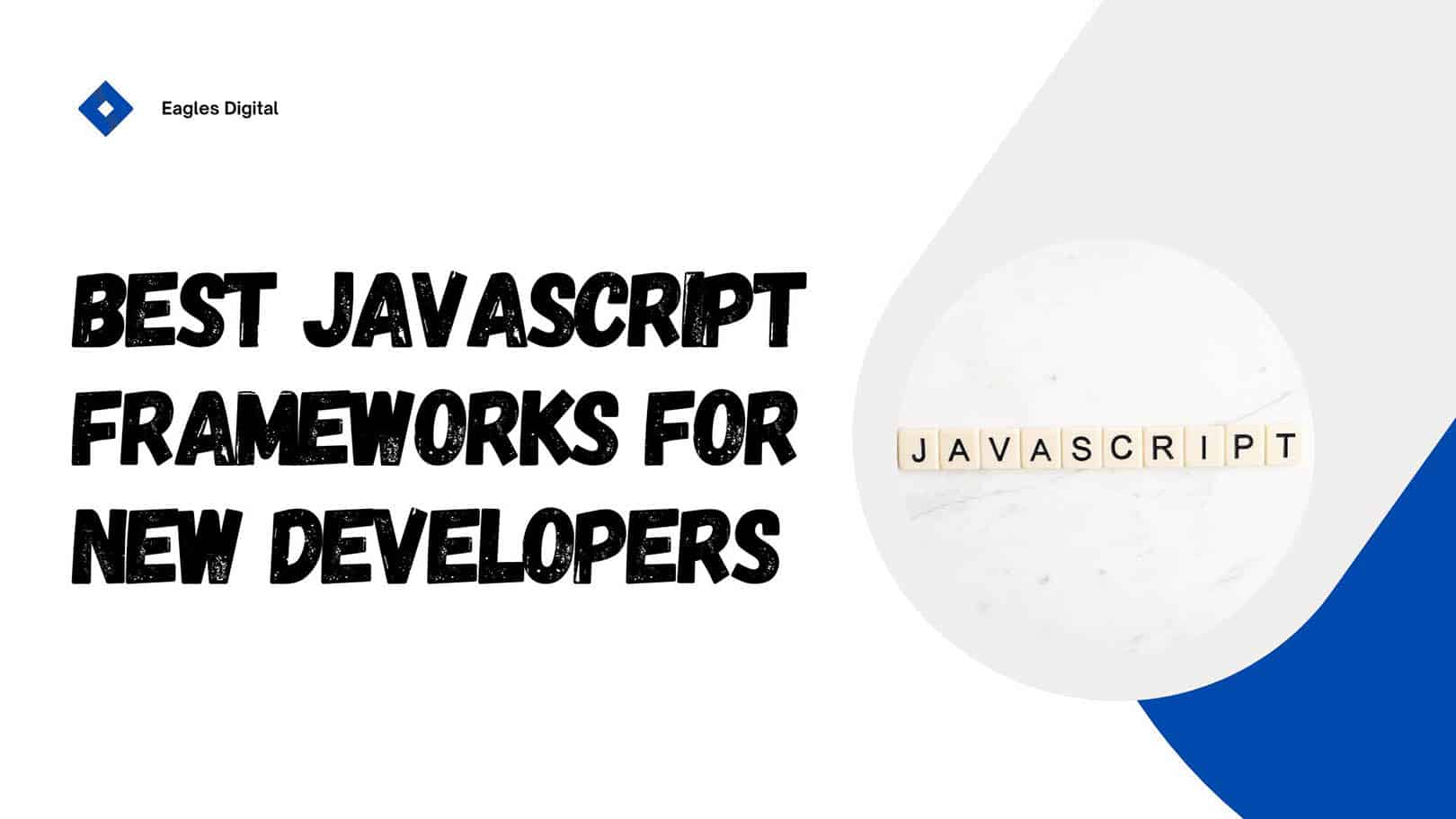7 Best JavaScript Frameworks for New Developers

As a developer, choosing the right programming languages is vital to improving productivity, writing clean and efficient code, and building scalable projects.
When it comes to JavaScript, the vast array of frameworks available can be overwhelming, especially for those just starting.
JavaScript is one of the most famous and versatile programming languages in the world. It powers over 90% of all websites, making it an essential skill for new developers.
Whether you’re looking to build dynamic web apps, interactive user interfaces, or simply learn the language, JavaScript frameworks are a great place to start.
To help you navigate the options, we’ve compiled a list of the 7 best JavaScript frameworks for new developers. These frameworks not only simplify the coding process but also offer powerful features to kickstart your development career.
Let’s get to the list.
What Are The Best JavaScript Frameworks for New Developers?
Here are the best JavaScript frameworks for new developers.
1. React
Best for: Building dynamic user interfaces, single-page applications, and cross-platform mobile apps.

React is arguably one of the most popular JavaScript libraries on this list, used by millions of developers worldwide.
It’s a flexible open-source JavaScript library for building user interfaces. Developed by Facebook, React has gained massive adoption due to its component-based architecture, performance and strong community support.
React is widely used by both small and large-scale businesses, making it a valuable skill for new developers to learn.
Key Features of React:
- React uses a virtual DOM (Document Object Model) to update the real DOM based on the identified changes, minimizing unnecessary re-renders.
- The framework allows you to break down your user interface (UI) into reusable components, making your code more modular and easier to maintain.
- React uses JSX which is a syntax extension that allows you to write HTML-like code inside JavaScript, making the structure of the user interface easier to visualize and understand.
- React provides a simple solution to add dynamic features to your existing project without a full rewrite.
- It also offers an excellent resource for those who want to learn more about the framework and how to use it to its full potential
Why It’s Great for Beginners:
React is great for beginners because it has a simple learning curve, allowing developers to master the core concepts quickly. Its component-based approach allows beginners to focus on creating small, modular elements that can be combined into larger applications.
Plus, React also has a huge community, making it easier to find tutorials, documentation, and support.
2. Angular
Best for: Large-scale enterprise applications and complex projects.

Angular is another popular JavaScript framework that follows a component-based approach. Its robust features and extensive community support make it a popular choice for developers worldwide.
Developed by Google, Angular is a versatile JavaScript framework capable of handling projects of all sizes, from small-scale initiatives to large-scale enterprise applications.
Unlike React, which focuses solely on the view layer, Angular is a complete MVC framework that includes everything you need to build powerful, dynamic applications.
Key Features of Angular:
- Angular includes a component-based framework that allows you to build scalable web applications
- It has a set of integrated libraries to handle tasks like routing, forms management, and client-server communication.
- Angular uses a two-way data binding to automatically sync data between the model (the data in your application) and the view (what the user sees).
- It also includes a wide range of developer tools to streamline development, testing, and updates, making the coding process more efficient.
Why It’s Great for Beginners:
Although Angular might take a bit longer to learn than React, it offers a complete toolkit for building powerful web apps without relying on third-party libraries as much. If you’re looking for a career in building large-scale apps, learning Angular could be a valuable asset.
3. Vue.js
Best for: Beginners and small to medium-sized projects.

Vue.js is an easy-to-learn JavaScript framework for building user interfaces. It enhances standard HTML, CSS, and JavaScript by offering a component-based approach, making it easier to create user interfaces, no matter how complex they are.
Vue.js allows you to start with basic components and then scale up to more complex functionalities as you become more comfortable with the framework. This progressive framework covers a wide range of common front-end development requirements.
Vue.js is a well-rounded tool that will help you take your user interface (UI) building to the next level.
Key Features of Vue.js:
- Vue.js’s component-based architecture allows you to build scalable and maintainable applications.
- Vue.js features reactive data binding, which automatically updates the UI whenever the underlying data changes, ensuring seamless interaction between the model and view
- Vue’s syntax is clean and easy to understand, even for new developers.
- It also integrates smoothly with existing projects, allowing developers to add Vue components incrementally without needing to reconfigure the entire codebase.
Why It’s Great for Beginners:
Vue’s gentle learning curve, coupled with powerful features, makes it an excellent choice for new developers. It’s a scalable framework that can grow with you and adapt to your needs.
On top of that, the Vue ecosystem is also very beginner-friendly, with clear documentation and a supportive community.
4. Svelte
Best for: Building performant and lightweight applications.

Svelte is a modern JavaScript framework known for its high performance and simplicity.
Unlike traditional frameworks that rely on virtual DOM manipulation, Svelte compiles your components into highly optimized JavaScript code at build time, resulting in faster rendering and improved performance.
Key Features of Svelte:
- Svelte uses a declarative syntax that is easy to read and write for new developers.
- It compiles your code into highly efficient JavaScript at build time, eliminating the need for a virtual DOM.
- Automatically updates UI components when data changes, making the code more intuitive.
- Svelte produces smaller bundle sizes compared to other frameworks, leading to faster load times.
Why It’s Great for Beginners:
Svelte’s simple syntax and lack of complex abstractions make it easy to learn for beginners.
It also allows you to build high-performance applications with minimal code, which can be motivating for new developers looking for fast results. While it’s not as widely adopted as React or Angular, Svelte is a great option if you’re looking for something new and innovative.
5. Ember.js
Best for: Building complex and scalable web applications.

Ember.js is a modern JavaScript framework designed for building feature-rich web applications. It offers a comprehensive set of features and tools that streamline the development process.
The framework comes with Ember CLI, a tool that streamlines development by automatically placing files and generating code.
Plus, Ember.js’s built-in data layer makes it easy to manage and manipulate data within your applications.
Key Features Ember.js:
- Similar to Angular and Vue, Ember provides automatic synchronization between the model and the view, making it easier to manage the application state.
- It has a powerful routing system that allows you to manage multiple views and states in a single-page application.
- The Ember CLI is one of the most advanced command-line tools for JavaScript, making it easier to generate components, routes, and services.
- Ember Inspector, your go-to tool for real-time application inspecting and spotting other Ember apps.
Why It’s Great for Beginners:
With Ember.js, developers have access to a powerful toolkit that simplifies the creation of modern web applications and facilitates rapid iteration. While it has a steep learning curve, Ember’s strong community support and built-in features make it ideal for learning how to build large, maintainable applications.
6. Node.js
Best for: Building scalable and high-performance web servers.

Node.js is a powerful, open-source runtime environment that enables you to execute JavaScript code on the server side, outside of a web browser. It’s popular for building scalable and efficient network applications, including web servers, APIs, and real-time applications.
Node offers many great features including non-blocking, event-driven architecture, which makes it ideal for handling multiple requests simultaneously.
Due to its ability to manage both server-side and client-side scripting, Node.js has become one of the most widely used and popular JavaScript frameworks in the industry.
While its asynchronous programming model can be challenging for beginners, it’s relatively easy to learn for those familiar with JavaScript.
Key features of Node.js:
- With asynchronous programming, Node.js can handle multiple tasks without blocking the execution of the program. This allows Node.js to efficiently manage I/O operations, such as reading files or querying databases, while continuing to process other requests.
- Node.js has a built-in module system that allows you to organize your code into reusable modules.
- You can use Node.js to build a wide range of applications, from simple websites to complex real-time applications
- Node.js is considered a single language for full-stack Development, which means you can use it and your skillset to build complete web applications.
- It also has a vast ecosystem of modules and libraries available through the npm package manager.
Why It’s Great for Beginners:
Node.js allows you to use JavaScript for both the front-end (client-side) and back-end (server-side) of your applications.
If you’re looking for a versatile JavaScript framework that can be used for Full-Stack Development, Node.js is worth considering.
7. Backbone.js
Best for: building lightweight or simpler applications.

Backbone.js is a lightweight JavaScript library that helps structure web applications by managing data and keeping your code organized. It’s based on the Model-View-Controller (MVC) pattern, helping you separate your code into distinct components for better management.
Backbone is flexible, scalable, and plays well with other libraries, making it great for small widgets or large applications. It focuses on simplicity and performance, making your apps easier to manage and run smoothly.
With Backbone.js, developers can create organized and efficient client-side web and mobile applications.
Key features of Backbone.js:
- Backbone.js is lightweight and easy to understand, allowing developers to read the source quickly.
- With Backbone.js, your views will automatically update to reflect changes in the model data.
- Manage URL routing and navigation within your application.
- It Provides a mechanism for communication between different parts of your application.
- Backbone.js integrates easily with other libraries and frameworks, making it ideal for building ambitious applications.
Why It’s Great for Beginners:
Backbone.js is a good choice for developers who prefer a minimalist and flexible approach to web development. It’s suitable for different types of projects, from small-scale applications to large-scale enterprise systems.
How to Choose the Best JavaScript Framework for New Developers?
With so many JavaScript frameworks available, it can be challenging to decide which one to start with. Here are a few factors to consider when choosing your first JavaScript framework:
1. Project Type:
If you’re building small-scale projects or working on static sites, frameworks like Vue.js or Svelte may be the best option due to their simplicity and low setup requirements.
For larger applications or enterprise-level projects, Angular and Ember provide more built-in functionality and scalability.
2. Learning Curve:
Frameworks like React and Vue.js have a more gentle learning curve, making them suitable for beginners. Angular and Ember, while powerful, have a steeper learning curve and are better suited for those willing to invest time in mastering them.
3. Community and Ecosystem:
A large community means more resources, tutorials, and third-party tools to help you along the way. React and Angular have large communities, while newer frameworks like Svelte are still growing but have excellent support.
Final Thoughts
Learning a JavaScript framework is an essential step for any developer looking to build modern web applications. Whether you choose the simplicity of Vue.js, the full-stack power of Node.js, or the flexibility of React, these frameworks provide the tools you need to create robust, maintainable, and scalable applications.
I highly recommend you start with a framework that aligns with your project needs and skill level. Once you’ve mastered the basics, you’ll find that switching between frameworks becomes easier, and you’ll gain valuable experience in different approaches to solving common development problems.
No matter which framework you choose, practice and hands-on experience are the keys to success in web development.


